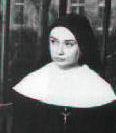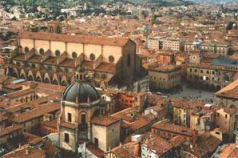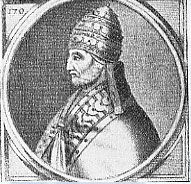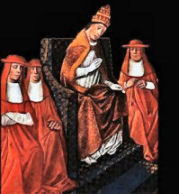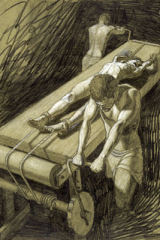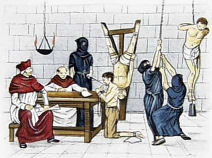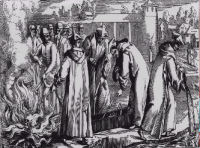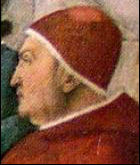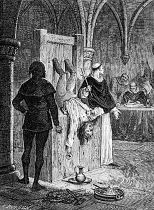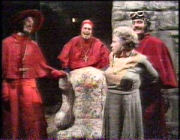Chapter 11: The I Word
Rest assured that the word “Inquisition” was never spoken in Sr. Mary Immaculata’s class. It would not surprise me if Sr. Torquemada or other school officials had taken a razor blade to the dictionary and the appropriate volume of the encyclopedia in each classroom.For centuries the Church invested a great deal of effort into creating the set of laws, rules, and regulations known as the canon. Even the earliest ecclesiastical authorities were quite adroit at forensic formulations. There was, however, a frustrating aspect; popes could compose laws at will, but for the most part they had no direct means of enforcing them outside of the Papal States. The Church has long promoted compliance by the faithful through guilt trips based on the lessons administered by the Ursulines and other orders. When that approach failed, the pope’s ultimate weapon was excommunication, and, with remarkably few exceptions, threat of its use kept even the nobility in line. However, for those already outside the Church the X-bomb was a dud. Because they were already damned by the Church’s reckoning, they would likely ignore its direct spiritual impact. Unless they relied upon trade with Christians, the indirect economic and social effects were likewise inconsequential. Crusades were the weapon of choice against infidels and heretics. However, they forced the popes to depend on kings and princes, who usually talked a good game, but when action was required, tended to follow their own agendas.
Beginning with the twelfth century the papacy was dominated by lawyers trained at the University of Bologna. These lawyer-popes devised a subtle trick to address the enforcement problem. They first goaded rulers, who sometimes relied on papal validation, into designating a target group as heretical criminals. In 1051 and 1052 Emperor Henry III sent some heretics to the gallows. Twenty-five years later the pyre became the method of choice for executing Cathars in Milan. Emperor Frederick II, of all people, laid the groundwork for governmental execution of religious dissidents when he declared heresy a capital crime. He even oversaw the burning of heretics. The second step entailed establishment of an ecclesiastic court with authority over such crimes. The Inquisition was instituted in 1184 by Pope Lucius III for that purpose. According to The Catholic Encyclopedia, “The Inquisitor … was a special but permanent judge, acting in the name of the pope and clothed by him with the right and the duty to deal legally with offenses against the Faith; he had, however, to adhere to the established rules of canonical procedure and pronounce the customary penalties.”[1] It might have added that in addition to the role of judge, he also functioned as prosecutor and jury. There was no defense attorney. Furthermore, the pope could change the “established rules” at will. And what about those “customary penalties?” Inquisitors “pronounced” the sentence, but they could not execute it. A pontifical trick assured that this legalistic distinction seldom impeded justice. In his papal bull of 1252, “Ad Extirpanda,” Pope Innocent IV required local officials to execute the Inquisitor’s sentence within five days. He also mandated – under pain of excommunication – that the emperor’s regulation specifying death by burning for heretics be entered into the laws of every city. The threat of excommunication was taken seriously. If the excommunication was not lifted within one year, the designee was considered a heretic, which subjected him to the Inquisition. One of the “established rules” specified in “Ad Extirpanda” was the use of torture to obtain confessions. Death and dismemberment were prohibited, but anything short of that was copasetic. The rack was fine, as long as one avoided cranking once too often. Palin’s work has demonstrated that by the time of the Spanish Inquisition even the comfy chair was allowed in some circumstances.[2]The manual used by the inquisitors was the Libro Nero. Its contents explain why the number of acquittals was so low.
Either the person confesses and he is proved guilty from his own confession, or he does not confess and is equally guilty on the evidence of witnesses. … Bodily torture has ever been found the most salutary and efficient means of leading to spiritual repentance. Therefore, the choice of the most befitting mode of torture is left to the Judge of the Inquisition, who determines according to the age, the sex, and the constitution of the party. … If, notwithstanding all the means employed, the unfortunate wretch still denies his guilt, he is to be considered as a victim of the devil; and, as such, deserves no compassion from the servants of God, nor the pity and indulgence of Holy Mother Church: he is a son of perdition. Let him perish among the damned.
The pope never technically gave the inquisitors carte blanche, but some judges definitely acted as if he had. Over the centuries untold numbers – thousands? millions?[3] – were tortured and/or burned alive for their purported beliefs.Perhaps the most disgusting aspect of all was the fact that when subjects confessed or were convicted, their possessions were confiscated and used to fund the Inquisition. In effect inquisitors were paid on a commission basis. This must have provided a strong incentive to stretch their authority. In some cases the informants, who were seldom identified to those accused, even shared in the confiscated loot!
Death provided no shelter from the Inquisition. The corpses of heretics were sometimes exhumed, tried, and burned. Why in the world would anyone do such a thing? Deep Throat’s admonition to “follow the money” is useful. Most of those posthumously prosecuted had bequeathed valuable property to their heirs. Confiscation followed conviction. Just as over time the popes augmented the concepts of crusades and indulgences, so too was the Inquisition’s scope eventually expanded. By the time that Pope Sixtus IV initiated the Spanish Inquisition in 1478, investigations mostly targeted Jews. A primary aim seemed to be confiscation of their property. The subsequent Roman Inquisition took aim at Protestants, who possessed enough flammable flesh to brighten the night sky. The Spanish Inquisition persisted until 1834. The “Sacred Congregation of the Holy Office” replaced the Roman Inquisition in 1908. Since 1965 it has been called the “Congregation for the Doctrine of the Faith.”Nuff sed. One should always look on the bright side of life, but what is to be gained by seeking the positive aspect of torturing people and then burning them at the stake for their religious beliefs or their possessions?
Sr. Mary Immaculata’s Rebuttal: The Inquisition started in the Middle Ages, a time when nearly all authorities were ruthless. The concept of human rights was not even a pipe dream in Europe. Trials before Inquisitors were usually preferable to being subject to the whims of ignorant medieval sovereigns. Few powerful people at the time considered the lives of ordinary people precious.
In her classroom, S’ter always had the last word, but not this time. Many medieval rulers were certainly ignorant, arbitrary, cruel, and ruthless. Some were probably even sociopaths. However, they never called themselves Vicars of Christ, and the pontiffs did. Almost all popes of the era had considerable legal training, and they executed a series of legal maneuvers to arrange a situation in which dissent became a capital offense. They appointed the judges and disallowed appeal. The official handbook for these trials practically mandated the use of torture to obtain confessions. If the popes never explicitly mandated the confiscation of convicted parties’ property, they obviously acquiesced in the widespread use of this execrable practice. The resulting system of the popes’ devising provided incentives for the accusation, conviction, and unspeakably painful execution of harmless people. The Inquisition was not used for violent offenses like murder and rape. Its subjects were charged with crimes of thought and speech.One last point: when the notions of human rights became popular in Europe, the popes resisted applying the concepts to their projects. The Inquisition flourished long after the human rights movement coalesced. Why should these well-educated popes need centuries to learn to esteem human life? Sr. Mary Immaculata taught us all that each human being is worth more than many sparrows. Where do you think she got the idea?
[1] The Catholic Encyclopedia, op. cit., Vol. VIII, p. 30.
[2] Monty Python's Flying Circus, Series 2, Show 2, "The Spanish Inquisition."
[3] A very long copyrighted but unpublished paper by David A. Plaisted, Professor of Communication at the University of North Carolina, has assembled an impressive array of estimates of the total number of deaths attributable to the papacy – not just the Inquisition – in the Middle Ages. Although Sr. Mary Immaculata would almost certainly deny many of the attributions, a case can be made that tens of millions of violent deaths can be closely, if not directly, tied to policies of the popes of this period.
 | |
 | |
Bankable Bar Bets
$ The judges of the Inquisition had no authority to administer punishments. They had to turn over the convicted people to the civil government.
$ The property belonging to people convicted by the Inquisition was often confiscated by the Church to fund the Inquisition’s activities. In some cases it shared with the people who had initiated the charges.
$ The Spanish Inquisition primarily targeted Jews; the Roman Inquisition primarily targeted Protestants.
$ Dead people were prosecuted by the Inquisition.
